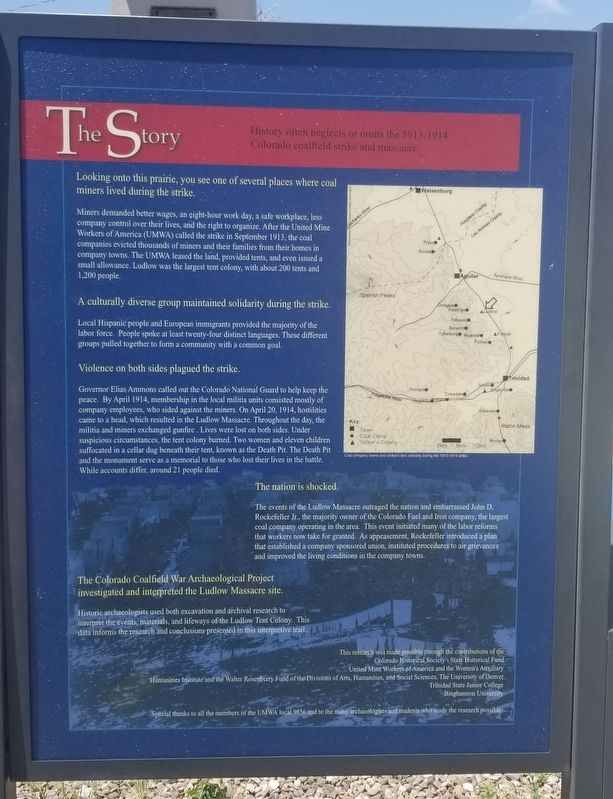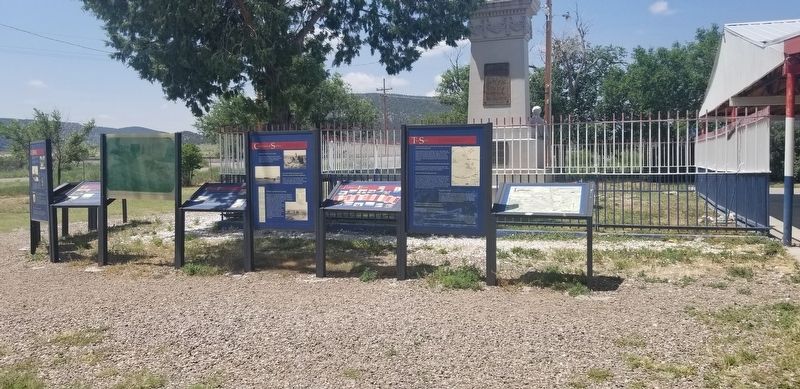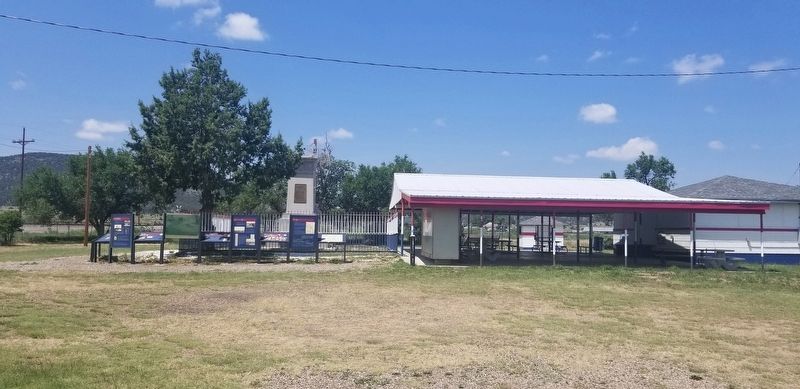Ludlow in Las Animas County, Colorado — The American Mountains (Southwest)
The Story
History often neglects or omits the 1913-1914 Colorado coalfield strike and massacre
Looking onto this prairie, you see one of several places where coal miners lived during the strike.
Miners demanded better wages, an eight-hour work day, a safe workplace, less company control over their lives, and the right to organize. After the United Mine Workers of America (UMWA) called the strike in September 1913, the coal companies evicted thousands of miners and their families from their homes in company towns. The UMWA leased the land, provided tents, and even issued small allowance. Ludlow was the largest tent colony, with about 200 tents and 1,200 people.
A culturally diverse group maintained solidarity during the strike.
Local Hispanic people and European immigrants provided the majority of the labor force. People spoke at least twenty-four distinct languages. These different groups pulled together to form a community with a common goal.
Violence on both sides plagued the strike.
Goverer Elias Ammons called out the Colorado National Guard to help keep the peace. By April 1914, membership in the local militia units consisted mostly of company employees, who sided against the miners. On April 20, 1914, hostilities came to a head, which resulted in the Ludlow Massacre. Throughout the day, the militia and miners exchanged gunfire. Lives were lost on both sides. Under suspicious circumstances, the tent colony burned. Two women and eleven children suffocated in a cellar dug beneath their tent, known as the Death Pit. The Death Pit and the monument serve as a memorial to those who lost their lives in the battle. While accounts differ, around 21 people died.
The nation is shocked.
The events of the Ludlow Massacre outraged the nation and embarrassed John D. Rockefeller Jr., the majority owner of the Colorado Fuel and Iron company, the largest coal company operating in the area. This event initiated many of the labor reforms that workers now take for granted. As appeasement, Rockefeller introduced a plan that established a company sponsored union, instituted procedures to air grievances and improved the living conditions in the company towns.
The Colorado Coalfield War Archaeological Project investigated and interpreted the Ludlow Massacre site.
Historic archaeologists used both excavation and archival research to interpret the events, materials, and lifeways of the Ludlow Tent Colony. This data informs the match and conclusions presented in this interpretive trail.
Captions
Upper Right: Coal company towns and strike's tent colonies during
the 1913-1914 strike
This research was made possible through the contributions of the Colorado Historical Society - State Historical Fund, United Mine Workers of America and the Women's Auxiliary, Humanities Institute and the Walter Rosenberry Fund of the Division of Arts, Humanities, and Social Sciences, The University of Denver, Trinidad State Junior College, Binghamton University. Special thanks to all the members of the UMWA local 9856 and to the many archaeologists and students who made the research possible.
Erected by UMWA Local 9856 Women's Auxiliary.
Topics. This historical marker is listed in these topic lists: Anthropology & Archaeology • Hispanic Americans • Industry & Commerce • Labor Unions. A significant historical month for this entry is April 1914.
Location. 37° 20.354′ N, 104° 35.03′ W. Marker is in Ludlow, Colorado, in Las Animas County. Marker is at the intersection of County Highway 44 and County Highway 61.5, on the right when traveling west on County Highway 44. The marker is located at the Ludlow Memorial in front of the monument. Touch for map. Marker is in this post office area: Trinidad CO 81082, United States of America. Touch for directions.
Other nearby markers. At least 8 other markers are within walking distance of this marker. Celebration & Sorrow (here, next to this marker); Company Towns (here, next to this marker); Tent Life (here, next to this marker); The Ludlow Massacre (here, next to this marker); United Mine Workers of America (here, next to this marker); Ludlow Tent Colony Site Memorial (here, next to this marker); Testimonies & Memories (here, next to this marker); Rediscovering Ludlow (a few steps from this marker). Touch for a list and map of all markers in Ludlow.
Also see . . . Ludlow Massacre.
The Ludlow Massacre was a mass killing perpetrated by anti-striker militia during the Colorado Coalfield War. Soldiers from the Colorado National Guard and private guards employed by Colorado Fuel and Iron Company (CF&I) attacked a tent colony of roughly 1,200 striking coal miners and their families in Ludlow, Colorado, on April 20, 1914. Approximately 21 people, including miners' wives and children, were killed. John D. Rockefeller Jr., a part-owner of CF&I who had recently appeared before a United States congressional hearing on the strikes, was widely blamed for having orchestrated the massacre. Source: Wikipedia(Submitted on March 15, 2022, by James Hulse of Medina, Texas.)
Credits. This page was last revised on March 15, 2022. It was originally submitted on March 15, 2022, by James Hulse of Medina, Texas. This page has been viewed 162 times since then and 12 times this year. Photos: 1, 2, 3. submitted on March 15, 2022, by James Hulse of Medina, Texas.


